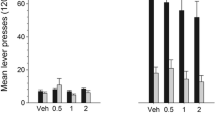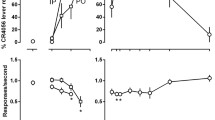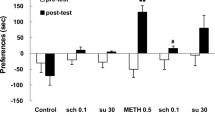Abstract
Rationale
Dopamine D3 receptor mechanisms have been implicated in the abuse-related behavioral effects of cocaine.
Objectives
The purpose of this study was to investigate the effects of the D3 receptor partial agonist CJB 090 on the discriminative stimulus, reinforcing and priming effects of cocaine in squirrel monkeys. Complementary studies were conducted to compare CJB 090’s effects on food-maintained behavior and species-typical unconditioned behaviors.
Methods
Monkeys were trained to: (1) discriminate cocaine from saline using a two-lever choice procedure, (2) self-administer cocaine on a second-order fixed-interval, fixed-ratio schedule of i.v. drug injection, or (3) self-administer food on a comparable second-order schedule of food delivery. A final group of monkeys served in quantitative observational studies of unconditioned behaviors.
Results
In cocaine discrimination studies, pretreatment with CJB 090 significantly attenuated cocaine’s discriminative stimulus effects. CJB 090 also significantly attenuated the partial cocaine-like stimulus effects of the preferential D3 receptor agonist PD 128907 but not the preferential D2 receptor agonist sumanirole. CJB 090 did not attenuate either self-administration of cocaine or cocaine-induced reinstatement of extinguished drug-seeking at a dose that reduced responding maintained by food. CJB 090 did not induce scratching or biting (species-typical effects of D2/3 receptor agonists) or catalepsy (typical effect of D2/3 receptor antagonists).
Conclusions
The results provide no evidence that CJB 090 reduced either the reinforcing or priming effects of cocaine but do suggest that CJB 090, acting via a D3 receptor mechanism, antagonized the discriminative stimulus effects of cocaine at a dose that did not induce adverse side effects.





Similar content being viewed by others
References
Acri JB, Carter SR, Alling K, Geter-Douglass B, Dijkstra D, Wikström H, Katz JL, Witkin JM (1995) Assessment of cocaine-like discriminative stimulus effects of dopamine D3 receptor ligands. Eur J Pharmacol 281:R7–9
Adewale AS, Platt DM, Spealman RD (2006) Pharmacological stimulation of group ii metabotropic glutamate receptors reduces cocaine self-administration and cocaine-induced reinstatement of drug seeking in squirrel monkeys. J Pharmacol Exp Ther 318:922–931
Ariens EJ (1983) Intrinsic activity: partial agonists and partial antagonists. J Cardiovasc Pharmacol 5:S8–S15
Beardsley PM, Sokoloff P, Balster RL, Schwartz JC (2001) The D3R partial agonist, BP 897, attenuates the discriminative stimulus effects of cocaine and D-amphetamine and is not self-administered. Behav Pharmacol 12:1–11
Benoit SC, McQuade JA, Clegg DJ, Xu M, Rushing PA, Woods SC, Seeley RJ (2003) Altered feeding responses in mice with targeted disruption of the dopamine-3 receptor gene. Behav Neurosci 117:46–54
Bergman J, France CP, Holtzman SG, Katz JL, Koek W, Stephens DN (2000) Agonist efficacy, drug dependence, and medications development: preclinical evaluation of opioid, dopaminergic, and GABAA-ergic ligands. Psychopharmacology (Berl) 153:67
Caine SB, Koob GF (1993) Modulation of cocaine self-administration in the rat through D-3 dopamine receptors. Science 260:1814–1816
Campiani G, Butini S, Trotta F, Fattorusso C, Catalanotti B, Aiello F, Gemma S, Nacci V, Novellino E, Stark JA, Cagnotto A, Fumagalli E, Carnovali F, Cervo L, Mennini T (2003) Synthesis and pharmacological evaluation of potent and highly selective D3 receptor ligands: inhibition of cocaine-seeking behavior and the role of dopamine D3/D2 receptors. J Med Chem 46:3822–3839
Cervo L, Carnovali F, Stark JA, Mennini T (2003) Cocaine-seeking behavior in response to drug-associated stimuli in rats: involvement of D3 and D2 dopamine receptors. Neuropsychopharmacology 28:1150–1159
Duarte C, Lefebvre C, Chaperon F, Hamon M, Thiébot MH (2003) Effects of a dopamine D3 receptor ligand, BP 897, on acquisition and expression of food-, morphine-, and cocaine-induced conditioned place preference, and food-seeking behavior in rats. Neuropsychopharmacology 28:1903–1915
Gilbert JG, Newman AH, Gardner EL, Ashby CR Jr, Heidbreder CA, Pak AC, Peng XQ, Xi ZX (2005) Acute administration of SB-277011A, NGB 2904, or BP 897 inhibits cocaine cue-induced reinstatement of drug-seeking behavior in rats: role of dopamine D3 receptors. Synapse 57:17–28
Grundt P, Carlson EE, Cao J, Bennett CJ, McElveen E, Taylor M, Luedtke RR, Newman AH (2005) Novel heterocyclic trans olefin analogues of N-{4-[4-(2, 3-dichlorophenyl) piperazin-1-yl]butyl}arylcarboxamides as selective probes with high affinity for the dopamine D3 receptor. J Med Chem 48:839–848
Grundt P, Prevatt KM, Cao J, Taylor M, Floresca CZ, Choi JK, Jenkins BG, Luedtke RR, Newman AH (2007) Heterocyclic analogues of N-(4-(4-(2, 3-dichlorophenyl) piperazin-1-yl) butyl) arylcarboxamides with functionalized linking chains as novel dopamine D3 receptor ligands: potential substance abuse therapeutic agents. J Med Chem 50:4135–4146
Gyertyan I, Saghy K (2007) The selective dopamine D3 receptor antagonists, SB 277011-A and S 33084 block haloperidol-induced catalepsy in rats. Eur J Pharmacol 572:171–174
Gyertyan I, Kiss B, Gal K, Laszlovszky I, Horvath A, Gemesi LI, Saghy K, Pasztor G, Zajer M, Kapas M, Csongor EA, Domány G, Tihanyi K, Szombathelyi Z (2007) Effects of RGH-237 [N-{4-[4-(3-aminocarbonyl-phenyl)-piperazin-1-yl]-butyl}-4-bromo-benzamide], an orally active, selective dopamine D(3) receptor partial agonist in animal models of cocaine abuse. J Pharmacol Exp Ther 320:1268–1278
Hall H, Halldin C, Dijkstra D, Wikström H, Wise LD, Pugsley TA, Sokoloff P, Pauli S, Farde L, Sedvall G (1996) Autoradiographic localisation of D3-dopamine receptors in the human brain using the selective D3-dopamine receptor agonist (+)-[3H]PD 128907. Psychopharmacology (Berl) 128:240–247
Heidbreder C (2008) Selective antagonism at dopamine D3 receptors as a target for drug addiction pharmacotherapy: a review of preclinical evidence. CNS Neurol Disord Drug Targets 7:410–421
Kenakin T (1997) Pharmacological analysis of drug-receptor interaction, 3rd edn. Lippincott-Raven, New York
Khroyan TV, Barrett-Larimore RL, Rowlett JK, Spealman RD (2000) Dopamine D1- and D2-like receptor mechanisms in relapse to cocaine-seeking behavior: effects of selective antagonists and agonists. J Pharmacol Exp Ther 294:680–687
Le Foll B, Sokoloff P, Stark H, Goldberg SR (2005) Dopamine D3 receptor ligands block nicotine-induced conditioned place preferences through a mechanism that does not involve discriminative-stimulus or antidepressant-like effects. Neuropsychopharmacology 30:720–730
Levant B (1997) The D3 dopamine receptor: neurobiology and potential clinical relevance. Pharmacol Rev 49:231–252
Martelle JL, Claytor R, Ross JT, Reboussin BA, Newman AH, Nader MA (2007) Effects of two novel D3-selective compounds, NGB2904 and CJB090, the reinforcing and discriminative stimulus effects of cocaine in rhesus monkeys. J Pharmacol Exp Ther 321:573–582
Mash DC, Staley JK (1999) D3 dopamine and kappa opioid receptor alterations in human brain of cocaine-overdose victims. Ann N Y Acad Sci 877:507–522
McCall RB, Lookingland KJ, Be´dard PJ, Huff RM (2005) Sumanirole, a highly dopamine D2-selective receptor agonist: in vitro and in vivo pharmacological characterization and efficacy in animal models of Parkinson’s disease. J Pharmacol Exp Ther 314:1248–1256
McQuade JA, Benoit SC, Xu M, Woods SC, Seeley RJ (2004) High-fat diet induced adiposity in mice with targeted disruption of the dopamine-3 receptor gene. Behav Brain Res 151:313–319
Millan MJ, Svenningsson P, Ashby CR Jr, Hill M, Egeland M, Dekeyne A, Brocco M, Di Cara B, Lejeune F, Thomasson N, Munoz C, Mocaër E, Crossman A, Cistarelli L, Girardon S, Iob L, Veiga S, Gobert A (2008) S33138 [N-[4-[2-[(3aS, 9bR)-8-cyano-1, 3a, 4, 9b-tetrahydro[1]-benzopyrano[3, 4-c]pyrrol-2(3H)-yl)-ethyl]phenylacetamide], a preferential dopamine D3 versus D2 receptor antagonist and potential antipsychotic agent. II. A neurochemical, electrophysiological and behavioral characterization in vivo. J Pharmacol Exp Ther 324:600–611
Murray AM, Ryoo HL, Gurevich E, Joyce JN (1994) Localization of dopamine D3 receptors to mesolimbic and D2 receptors to mesostriatal regions of human forebrain. Proc Natl Acad Sci USA 91:11271–11275
Nader MA, Mach RH (1996) Self-administration of the dopamine D3 agonist 7-OH-DPAT in rhesus monkeys is modified by prior cocaine exposure. Psychopharmacology (Berl) 125:13–22
Newman AH, Cao J, Bennett CJ, Robarge MJ, Freeman RA, Luedtke RR (2003) N-(4-[4-(2, 3-dichlorophenyl) piperazin-1-yl]butyl, butenyl and butynyl) arylcarboxamides as novel dopamine D(3) receptor antagonists. Bioorg Med Chem Lett 13:2179–2183
Newman AH, Grundt P, Nader MA (2005) Dopamine D3 receptor partial agonists and antagonists as potential drug abuse therapeutic agents. J Med Chem 48:3663–3379 Review
Palmiter RD (2007) Is dopamine a physiologically relevant mediator of feeding behavior? Trends Neurosci 30:375–381
Pilla M, Perachon S, Sautel F, Garrido F, Mann A, Wermuth CG, Schwartz JC, Everitt BJ, Sokoloff P (1999) Selective inhibition of cocaine-seeking behaviour by a partial dopamine D3 receptor agonist. Nature 400:371–375
Platt DM, Rowlett JK, Spealman RD (2000) Dissociation of cocaine-antagonist properties and motoric effects of the D1 receptor partial agonists SKF 83959 and SKF 77434. J Pharmacol Exp Ther 293:1017–1026
Platt DM, Rowlett JK, Spealman RD (2001) Modulation of cocaine and food self-administration by low- and high-efficacy D1 agonists in squirrel monkeys. Psychopharmacology (Berl) 157:208–216
Platt DM, Rowlett JK, Spealman RD (2002) Behavioral effects of cocaine and dopaminergic strategies for preclinical medication development. Psychopharmacology (Berl) 163:265–282 Review
Platt DM, Carey G, Spealman RD (2005) Intravenous self-administration techniques in monkeys. Curr Protoc Neurosci 9:9.21
Pritchard LM, Newman AH, McNamara RK, Logue AD, Taylor B, Welge JA, Xu M, Zhang J, Richtand NM (2007) The dopamine D3 receptor antagonist NGB 2904 increases spontaneous and amphetamine-stimulated locomotion. Pharmacol Biochem Behav 86:718–726
Pugsley TA, Davis MD, Akunne HC, MacKenzie RG, Shih YH, Damsma G, Wikström H, Whetzel SZ, Georgic LM, Cooke LW, DeMattos SB, Corbin AE, Glase SA, Wise LD, Dijkstra D, He¤ner TG (1995) Neurochemical and functional characterization of the preferentially selective dopamine D3 agonist PD 128907. J Pharmacol Exp Ther 275:1355–1366
Pulvirenti L, Koob GF (1994) Dopamine receptor agonists, partial agonists and psychostimulant addiction. Trends Pharmacol Sci 15:374–379 Review
Segal DM, Moraes CT, Mash DC (1997) Up-regulation of D3 dopamine receptor mRNA in the nucleus accumbens of human cocaine fatalities. Brain Res Mol Brain Res 45:335–339
Self DW, Barnhart WJ, Lehman DA, Nestler EJ (1996) Opposite modulation of cocaine-seeking behavior by D1- and D2-like dopamine receptor agonists. Science 271:1586–1589
Spealman RD (1996) Dopamine D3 receptor agonists partially reproduce the discriminative stimulus effects of cocaine in squirrel monkeys. J Pharmacol Exp Ther 278:1128–1137
Spealman RD, Bergman J, Madras BK, Melia KF (1991) Discriminative stimulus effects of cocaine in squirrel monkeys: involvement of dopamine receptor subtypes. J Pharmacol Exp Ther 258:945–953
Thanos PK, Michaelides M, Ho CW, Wang GJ, Newman AH, Heidbreder CA, Ashby CR Jr, Gardner EL, Volkow ND (2008) The effects of two highly selective dopamine D3 receptor antagonists (SB-277011A and NGB-2904) on food self-administration in a rodent model of obesity. Pharmacol Biochem Behav 89:499–507
Weiss F, Maldonado-Vlaar CS, Parsons LH, Kerr TM, Smith DL, Ben-Shahar O (2000) Control of cocaine-seeking behavior by drug-associated stimuli in rats: effects on recovery of extinguished operant-responding and extracellular dopamine levels in amygdala and nucleus accumbens. Proc Natl Acad Sci U S A 97:4321–4326
Witkin JM, Nichols DE, Terry P, Katz JL (1991) Behavioral effects of selective dopaminergic compounds in rats discriminating cocaine injections. J Pharmacol Exp Ther 257:706–713
Wong DF, Kuwabara H, Schretlen DJ, Bonson KR, Zhou Y, Nandi A, Brasić JR, Kimes AS, Maris MA, Kumar A, Contoreggi C, Links J, Ernst M, Rousset O, Zukin S, Grace AA, Lee JS, Rohde C, Jasinski DR, Gjedde A, London ED (2006) Increased occupancy of dopamine receptors in human striatum during cue-elicited cocaine craving. Neuropsychopharmacology 31:2716–2727
Xi ZX, Gilbert JG, Pak AC, Ashby CR Jr, Heidbreder CA, Gardner EL (2005) Selective dopamine D3 receptor antagonism by SB-277011A attenuates cocaine reinforcement as assessed by progressive-ratio and variable-cost-variable-payoff fixed-ratio cocaine self-administration in rats. Eur J Neurosci 21:3427–3438
Xu M, Koeltzow TE, Santiago GT, Moratalla R, Cooper DC, Hu XT, White NM, Graybiel AM, White FJ, Tonegawa S (1997) Dopamine D3 receptor mutant mice exhibit increased behavioral sensitivity to concurrent stimulation of D1 and D2 receptors. Neuron 19:837–848
Acknowledgements
The authors thank Jianjing Cao in the Medicinal Chemistry Section, NIDA-IRP, NIH for the synthesis of CJB 090, Shana Langer and Kristen Bano for technical contributions, and Donna Reed for editorial assistance.
Support
This work was supported by United States Public Health Service Grants DA011054, DA017700, NIDA-IRP and RR00168.
Author information
Authors and Affiliations
Corresponding author
Rights and permissions
About this article
Cite this article
Achat-Mendes, C., Platt, D.M., Newman, A.H. et al. The dopamine D3 receptor partial agonist CJB 090 inhibits the discriminative stimulus but not the reinforcing or priming effects of cocaine in squirrel monkeys. Psychopharmacology 206, 73–84 (2009). https://doi.org/10.1007/s00213-009-1581-9
Received:
Accepted:
Published:
Issue Date:
DOI: https://doi.org/10.1007/s00213-009-1581-9




